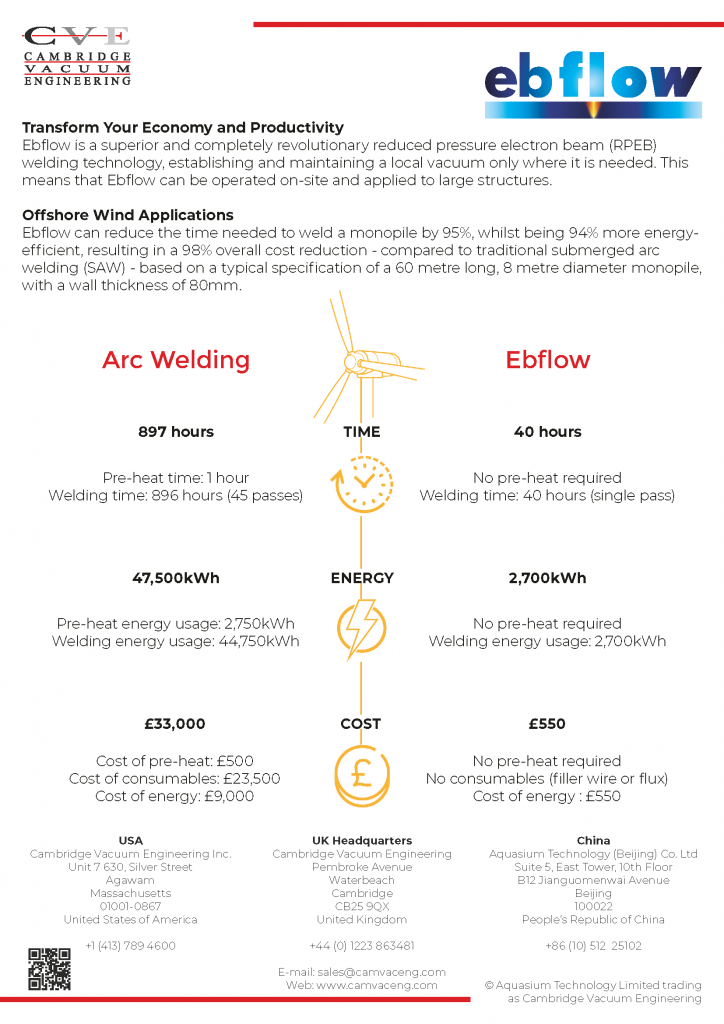Dogger Bank Wind Farm to Pioneer Ebflow
Ground Breaking Joint Effort: Dogger Bank Wind Farm to Pioneer Ebflow Technology
The developers of the world’s largest offshore wind farm will carry out the first large-scale pilot of Ebflow for the welding of monopiles, which will reduce welding times by as much as 80%.
CVE’s Ebflow technology is expected to be used at the Dogger Bank A phase of the wind farm, to fabricate welds on offshore wind foundation monopiles, reducing the time it takes to carry out the task from several hours to a matter of minutes.
It will be the first time that reduced pressure electron beam (RPEB) has been used on a large-scale offshore infrastructure project and will take place under a collaborative project named RapidWeld.
The RapidWeld Project
The RapidWeld project aims to create an industry-approved weld process for offshore wind, which is more productive and sustainable than established methods while reducing energy and material costs significantly.
The project team comprises of:
- SSE Renewables, a leading developer, owner, and operator of renewable energy across the UK and Ireland
- Sif, a global leading manufacturer of offshore foundations
- TWI, the UK’s foremost welding research establishment
- Cambridge Vacuum Engineering, the designer and manufacturer of Ebflow
How Ebflow Works
Ebflow is a reduced pressure electron beam (RPEB) technology that uses heat generated by a beam of high energy electrons to make a high strength and durable welded steel join, cleanly and efficiently.
Ebflow uses a local vacuum, allowing the system to be readily transported and operated on-site and applied to structures significantly larger than those that can be accommodated in a vacuum chamber.
Ebflow will streamline the fabrication process for offshore wind farms, further increasing the efficiency of large-scale projects and demonstrating increased cost-effectiveness of renewable energy for consumers.
Ebflow will also reduce the carbon emissions associated with the traditional welding methods by 90%.
The RapidWeld project is expected to develop methods that outstrip existing welding technology and reduce the costs of future offshore wind foundation monopiles by up to 20%.
Dogger Bank Wind Farm
A joint venture between SSE Renewables, Equinor and Eni, SSE Renewables is leading the construction and delivery of Dogger Bank, while Equinor will operate the wind farm on operation. When complete, Dogger Bank will be the largest offshore wind farm in the world.
Steve Wilson, SSE Renewables Project Director for Dogger Bank Wind Farm said:
“This is a ‘first-in-class’ project, establishing this UK innovation as world-leading technology. With monopile type foundations accounting for over 90% of foundations used in UK projects, Ebflow RPEB could realise significant cost savings on future projects.
“These substantial savings will not only benefit the UK offshore engineering industry but could be passed on to UK energy consumers.
“It’s exciting that Ebflow is being used at Dogger Bank – a project which continues to contribute to the UK economy by creating jobs and supporting to the supply chain. No doubt, other offshore projects across the world could ultimately benefit from what the RapidWeld partnership achieves.”
The project has been made possible with a smart grant of £600k from Innovate UK, which is part of the UK Government-backed Research and Innovation organisation.
Sif will be responsible for the fabrication and supply of 190 monopiles and primary steel for the transition pieces, as well as for the marshalling of all foundation components for the first two phases of Dogger Bank Wind Farm.
Chief Operating Officer for Sif, Frank Kevenaar said:
“We see great potential in the Ebflow RPEB welding process for thick section welding. Reduced distortion and elimination of filler material are, amongst others, great advantages. We are very pleased to have the opportunity to contribute to this innovative project that is joining forces and expertise to create new cost-effective production methods.”
Submerged Arc Welding vs Ebflow
Ebflow can reduce the time needed to weld a monopile by 95%, whilst being 94% more energy efficient, resulting in a 98% overall cost reduction – compared to traditional submerged arc welding (SAW) – based on a typical specification of a 60 metre long, 8 metre diameter monopile, with a wall thickness of 80mm.

View the full datasheet or find out more about Ebflow.